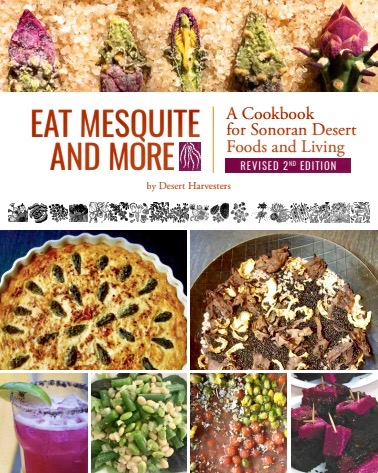Spring finds Southern Arizona desert communities deep in citrus of all kinds. Our grapefruit tree died but I never lack for grapefruit because there are so many productive trees in Tucson owned by people who either don’t like grapefruit or have way more than they can use. This recipe also uses poppy seeds that I grow in my garden. I planted some years ago and do harvest the seeds carefully, but once again, there are so many seeds some drop to the ground and carefully wait out the summer heat to reappear the next winter.

Grapefruits are abundant now in desert communities.
The desert Southwest is awash in citrus every spring. This includes oranges, grapefruits, tangerines and little fruits such as calamondins. Many folks who have a grapefruit tree in their yard find they have way too many, either because they don’t like them or the trees have produced way more than they care to eat. Iskashitaa, a nonprofit that organizes refugees and local citizens into harvest groups, gathers the unwanted fruit and distributes it to those in need or those willing to pay for it. This year has seen a really bountiful harvest.

Zeru, from Eritrea, an Iskashitaa volunteer, is thrilled with this one-day harvest of grapefruit and lemons.
Our grapefruit tree died and our replacement tree hasn’t gotten organized yet to produce fruit, but the two grapefruit lovers in our household have been blessed by gifts from our neighbor and the Iskashitaa bounty.
This recipe for Grapefruit Poppy Seed Bread gets a little crunch from tiny poppy seeds. I grow my own in my garden. I don’t even have to sow them anymore. Plenty of seeds spill when we’re harvesting them and by January they are coming up in the lettuce garden. They destroy the tidy look of the lettuce in rows, but I can’t bear to pull them out, so by now the garden is messy with poppies, nasturtiums, and lettuce somewhere down under everything.

Oriental poppies produce thousands of tiny seeds and self-sow easily. Those round objects are the seed pods and when they dry, it is easy to shake out the seeds. Always some fall to the ground and nestle there until they decide to grow the following winter.
This Grapefruit Poppy Seed Bread has a sweet fruity flavor but it’s hard to detect that it is actually grapefruit. So if you aren’t that keen on grapefruit, this might be a good way to use up some fruit.
Some tips before we get to the recipe. I always line my pans with parchment baking paper or foil to help get the loaves out in one piece. This particular bread seems very tender when it first comes out so the lining is important.
Here’s a picture of poking the bread with a skewer to let the syrup penetrate the bread easier.

Use a skewer, a toothpick, or even a fork to make holes to allow the glaze to penetrate.
And the beautiful finished bread. This is what you are aiming for.

Finished grapefruit bread with drizzled glaze
Grapefruit Poppy Seed Bread
1 cup butter, softened
1-2/3 cups sugar, divided
3 large eggs, room temperature
3/4 cup yogurt
3 tablespoons poppy seeds
¼ cup grated grapefruit zest
2 teaspoons vanilla extract
2 cups all-purpose flour
1/2 teaspoon baking soda
1/4 teaspoon salt
1/4 cup grapefruit juice
Glaze:
1 cup confectioners’ sugar
2 tablespoons grapefruit juice
1 tablespoon grapefruit zest
Preheat oven to 350°. In a large bowl, cream butter and 1-1/3 cups sugar until light and fluffy, 5-7 minutes. Add eggs, 1 at a time, beating well after each addition. Beat in yogurt, poppy seeds, grapefruit zest and vanilla. In another bowl, whisk flour, baking soda and salt; gradually beat into creamed mixture.
Transfer to a greased 9×5-in. loaf pan. Bake until a toothpick inserted in center comes out clean, 55-65 minutes. Meanwhile, in a small bowl microsafe bowl, mix grapefruit juice, 1 tablespoon grapefruit zest, and remaining sugar. Microwave for 1 minute to make a simple syrup. Set aside.
Remove bread from oven. Immediately poke holes in bread with a fork; slowly pour juice mixture over bread. Cool in pan 10 minutes before removing to a wire rack to cool completely. The bread is very tender at this point. The cooling in the pan is a necessary step.
In a small bowl, mix glaze ingredients. Carefully remove bread from pan and set on a wire rack and continue to cool; drizzle glaze over bread.

A few pieces of grapefruit bread make a lovely breakfast or a treat when hunger gnaws in the afternoon.
___________________________________________________________

I’m thrilled to announce that my new book A Desert Feast: Celebrating Tucson’s Culinary Heritage has won two awards. It was named a Top Pick in the Southwest Books of the Year list and also won a PubWest award for design. The latter was particularly satisfying because it honored Leigh McDonald and Sara Thaxton who did the extremely complex layout that makes the book so visually stunning. It was as if they entered my brain and executed exactly what I had been hoping for. Order your copy from your local book store, from Native Seeds/SEARCH, or on-line.








































































